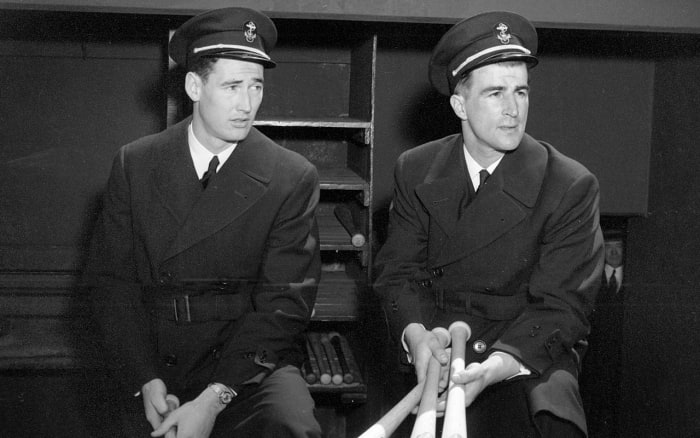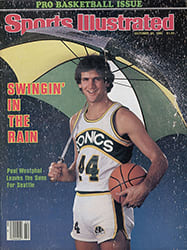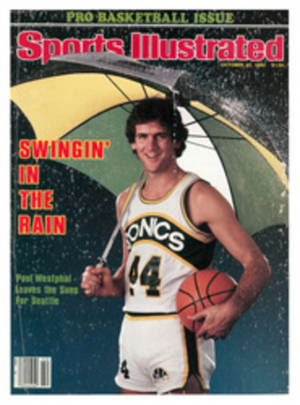Some Non-mountainous Mountains were Peaks of the Author's Youth
So much is gone from the Boston we knew then: the Braves, the Victory Gardens of World War II, and, most notably, that wild city block we called The Mountains. Only the gnarled old oak at its edge remains, only that and seemingly smaller now, but, then, I am larger. The oak stands beside an aqua-colored motel, which sprawls where The Mountains—and, in a sense, the Boston I used to know—were. Once there was Scollay Square, that sailors' delight. Now something called Government Center sits in its place, and you can't even get a decent tattoo anymore.
Boston was a two-team baseball city in the mid-'40s. The Braves were years away from Milwaukee, and each kid in my crowd thought he was Spahn or Williams or, in my case, Red Sox Shortstop Vernon Stephens. My batting stance was very wide, almost like Junior Stephens', everyone said. So I kept making it wider until I could hardly stand up even while waiting for a pitch. And I would fall down with every wild swing. Once I pulled a long foul. After that each time I came to bat the other kids would say, "Boy, if he ever connects...." I hardly ever did, though, and I kept falling down, content with my reputation as the biggest threat on the block. Hitting was my obsession, but that was all I knew of baseball.
What I really loved was to be on The Mountains, a tiny urban oasis of hills and dales and secret groves. That was where we had our rock fights, raining jagged, egg-sized chunks of granite from a cliff onto the kids from another neighborhood. Finally one 6- or 7-year-old too many ran screaming down the hill, blood pouring from his head, and the rock fights ended abruptly. They had lasted only a year or two, and I've never understood what provoked them. But as with so many other things in those first 12 years of my life—the games, the madness and the growing up that came so suddenly—the rock fights are impressed forever in my mind, like a prom flower in a scrapbook.
My family lived on the second floor of a brick apartment house at the top of a hill, with a porch overlooking The Mountains. The oak tree was just below, and behind it a circle of bushes and small trees surrounding a clearing—our boxing ring. Six or eight of us used it one spring. I wasn't the tallest or the strongest or the heaviest, but, as in baseball, I was considered a threat. My opponents were always warned, "Watch out for his uppercut." I liked that, and out I would charge, my right arm a driving piston. But I never hit anyone very hard, and a younger, smaller kid named Denny Miller always beat the hell out of me.
To the left of the clearing was a terrific cliff made of pudding stone. I now realize it was, at best, nine feet high. Beneath the cliff was a large hollow or bowl, and on its far side, partially buried, were the remains of an old brick wall that we dug away at over the years. I told myself I might become an archaeologist when I grew up, but I never bothered to learn the age of the wall or its origin. Now no one ever will.
The Mountains was the place to which we escaped. It was a time for that. I was three when the Japanese attacked Pearl Harbor, and I recall my mother switching off the lights at night as neighborhood men in air-raid-warden helmets stood on the sidewalks, gazing at the sky. When you are four or five years old, seeing something like that colors your whole life. At school, while the girls sketched hairdos, the boys drew pursuit planes, diving, climbing, shooting and crashing. The fighters were what we saw when we looked at the sky. To get closer to the real thing we stood on the cliff, and for half a decade every plane that flew over our neighborhood was "in trouble."
"Look, the wing's falling off."
"The engine's on fire."
"He'll never make it to the airport."
All the boys on our street made model airplanes, intricate webs of balsa-wood sticks covered with tissue paper, stretched skintight. Most of us took weeks to finish a plane, but an older boy named Herbie could put one together in a day or two. He was our idol. When he had completed a model and brought it outside, a crowd was always waiting, and the same thing always happened. He'd lead us to the cliff, wind up the model's rubber band and, as he launched the plane into the air, set it on fire. It would float out over the hollow and disintegrate in flames, just the way all the other aircraft that flew over our neighborhood did.
That was the beginning of the Herbie legend. He went on to pitch for Brighton High, to play semipro ball and to sign a contract with our Braves. For years we watched the sports pages for his name to turn up with the big club, but it never did. Even now when two old friends from the neighborhood meet, they invariably discuss Herbie and ask each other why it was that he never made the Braves.
Beyond the cliff where Herbie flew his planes were groves that could not be seen from any apartment or street. It was there, for one spring only, that my younger brother Steve and I had our cookouts. We built small fires and in the coals buried potatoes that we had spirited from our kitchen. They were awful, hard and flecked with ashes, but we loved them. We kept swiping spuds and cooking in the coals all that spring, and no one ever knew.
In front of each apartment house in my neighborhood was a flight of stairs. They were essential to a game we played a lot in the late '40s and early '50s called Cards. We would slide our baseball, football and war cards toward the bottom stair, trying for a leaner, a winner. All the cards came in bubble-gum packs, and some of the war ones featured pictures of American soldiers, tanks and planes bombing and massacring Oriental armies. That series of cards was called The Red Menace, which at first I imagined was some kind of creeping, jellylike scarlet protoplasm that could ooze over oceans and continents and, judging from the cards, would soon be lapping at our Mountains.
We also used the apartment stairs for Up Against, a ball game. One player would throw a pink rubber ball called a high bouncer at the stairs, with one, two or three fielders spread out from the sidewalk to the other side of the street. Everyone threw the ball very hard, aiming for the front edge of a step. If the throw was on target, the result was a lovely hollow thunk and a long line-drive hit. Most balls, however, were grounders, which might have developed a lot of good baseball infielders had those future Gold Glovers not ruined their arms throwing the light ball so hard against the stairs.
For a while in the late '40s we were also into roller skating—clamp-on skates, 30 years away from roller disco rinks. We'd leap off and onto the curb as we rolled, screaming down the hill to the yard of the Harriet A. Baldwin School. The yard had a smooth tar surface that rose and dipped in places, and gliding over it created a vibrating sensation that shot through the skates, into our feet and up our legs. This was more fun than hitting the edge of a step, but for us roller skating was just a passing fancy. Beanshooters came in for a season, and the shelves of local markets were emptied of beans, until the Baldwin School banned beanshooting. They, too, were soon forgotten, to be followed by yo-yos. The world yo-yo champion came to The Mountains to demonstrate his tricks and to hold contests at a store selling the wares of the company he represented. The winner of a contest would get a yo-yo with glass chips set in its side, a diamond yo-yo, and if one bought a yo-yo, diamonds or not, the world champion would carve a palm tree and one's name in its side. He returned many times that year and the next, but yoyos must have been popular on many worlds because the same world champion never came twice.
As we were growing weary of yo-yos, some fundamental changes were taking place in our lives. Our street and sidewalk games were ending, and even The Mountains seemed less wonderful. Our rock fights had long been forgotten, and the kid who owned the boxing gloves moved. We now were old enough to leave the neighborhood, and a few miles away was a playground with baseball diamonds and tennis courts that were flooded in the winter for ice skating. We went there after school to play hockey, but soon I was skating on a court that was closed to hockey. I was 12 that winter, and there were girls on that court.
Everything seemed to be changing at once for me. My parents had begun to look for a home in a town with a better school system than Boston's, but I didn't want to move. No 12-year-old ever does. We moved anyway, in early spring, four miles west to Newton Centre. That May I turned 13. One evening I was riding my bicycle through my new neighborhood and stopped on a street where a stickball game was under way. There seemed to be some good hitters playing. A young girl in white shorts was watching from the curb. She had large, dark eyes, and a voice that I later would liken to the tinkling of wind chimes. I watched her silently. In the days that followed I realized I would have to make some accommodation with what I was feeling. I would have to start doing things differently. So I began combing my hair very carefully. And I tightened up my batting stance.


